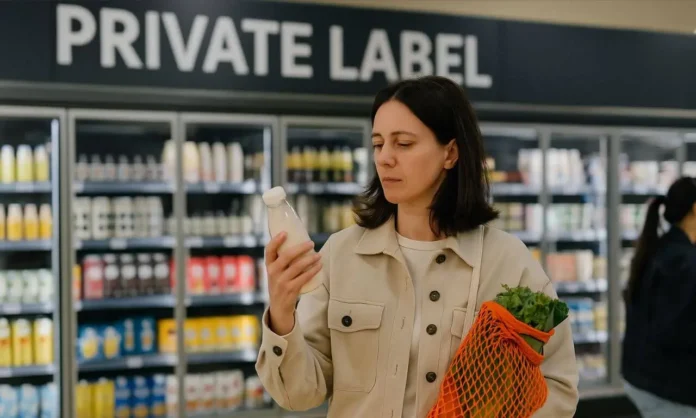Private labels are gaining new ground to $271 billion in 2024. That was up 3.9 percent from the previous year. National brand sales rose just 1% during that same time. Refrigerated foods, packaged groceries and beverages were strongest.
Each of the 10 grocery and non-food departments monitored in the report experienced year-over-year sales growth. Store brands deepened and broadened their appeal across cheap and premium categories.
Today in Europe shelf space is dominated by store brands. Private labels in Switzerland hold a bigger pie of over 51% of grocery value share. Other standout territories follow Germany, the Netherlands and the UK.
Private label market growth is increasing rapidly outside Europe. In a 2024 survey, 61% of German, 59% of Saudi, and 56% of Indian and Colombian shoppers reported that they were purchasing more store brands than they ever had, reports from Statistica. All of these numbers were higher than the world average of 50 %.
Key Drivers Behind Growth
The growth in the private label market is related to changes in shopper behaviour and retailer strategy. Store brands benefited in recent years from high inflation that prompted more consumers to shift to them. The move has persisted as prices started to stabilize.
Retailers seized the opportunity to extend their private label lines. Many launched new brands to meet modern demand such as health, wellness, convenience and sustainability.
The young are an important growth market. Gen Z and Millennial consumers propelled private label adoption in urban areas last year. These buyers are seeking low cost, good quality and transparent product display.
“Private label is now a smart choice, and not just a cheap one.”
Leading Retail Markets
Store brands grew in almost every retail channel in North America. Everyone from super markets to club stores, to discounters, to online grocers grew their private label offerings. Refrigerated foods and shelf staples, which include ingredients like flour, sugar and oil, along with household products did well.
AND EUROPEANS Still Top Value Store BRAND share Europe s share remains the highest in the world. There are now standard multi-tier models that provide budget, mid-range, and premium options available under different store brand labels.
Higher inflation fueled growth in the Middle East and Africa. Value growth of private label was up 34.3% in 2024. Latin America was next with 14.2 percent value growth. These sales gains resulted from both price impact and volume growth.
India reported strong momentum in Asia-Pacific. In 2024, 56 percent of Indian shoppers said they were purchasing more store brand products. Growth is focussed on leisure-based modern supermarkets in urban areas.
Strong-Growth Categories

Largest New Growth in 2024 by:
Refrigerated items – up 7.5%
General groceries and beverages – each up around 4%
Fresh produce – expanded through branded in-house lines
Health-oriented foods – plant-based, gluten-free, and low-sugar items
Non-food – household cleaning and paper products also posted steady gains
Retailers are creating full assortments across all price segments. Some of them are introducing exclusive store brands with specific themes, such as wellness or sustainability.
Shopper Preferences by Age
A changing of the guard is reshaping the private label market.
Millennials and Gen Z are open to purchasing private label products across more categories. They are value oriented, but respond to clear packaging, identifiable design and overt messaging.
Older shoppers are also less likely to switch. They are more brand-loyal in core areas like cooking oil, personal care and snacks.
Retailers are using shelf design, app features and loyalty programs that connect to their private label brands to reach younger shoppers.
Trust and Quality Perception
In 2024, consumers said they gravitate toward private label for four key reasons:
- Consistent quality
- beat this price better then national kind.
- Store trust and visibility
- Simpler and clearer packaging
Retailers have been investing in better packaging. ‘There are now a lot of new private label launches that have modern fonts and cleaner layouts and the introduction of environmental icons. These changes enhance shelf impact and close the perceptual gap with national brands.
Store brand growth now includes fresh, chilled, dry grocery and household. Retailers’ quality control and supplier-partnership investments, coupled with exclusive packaging systems, are working over time.
Long-Term Forecast
Private label continues to move along the trend line, for the next five years. In-house programs are strengthening at retailers and product line extensions are occurring in both food and non-food categories.
Growth will be flat to only modestly higher in developed countries and emerging economies between 2025 and 2030. The key growth drivers will be margin management, consumer confidence, and retail spread.
In Europe and North America, the strategic emphasis is on premiumization, innovation and loyalty. Growth in Asia and Latin America will be driven by income growth, sensitivity to inflation and private investment in modern retail.
Retailers will have to invest in direct sourcing and exclusive supplier partnerships and be better than ever at private label marketing.
Strategy by Region
In the U.S., retailers are emphasizing mid-tier and high-end store brands. Natural food, fresh produce and better-for-you categories are performing well. Private label is being relied upon to shift dependence from expensive national brands.
In Canada, grocery stores are increasingly broadening their store brand offerings via mass and specialty retail. Themes of health and sustainability permeate.
Private label will continue to prevail in Europe. Chains are upgrading packaging, introducing new sub-brands and creating private label-only forms. Price competition with brands is fierce, but store brand trust is high.
In Asia the growth will come with supply chain expansion. Private label penetration at the urban supermarket level will be on the rise in India, China and Southeast Asia as well. Even in these markets shoppers favour branded over unbranded goods, but this is shifting as confidence in store-level quality increases.
Private label and regionally sourced value will be key in Latin America and the Middle East. Inflationary pressure is high and store brands provide a means for consumers to save money.
E-Commerce and the Internet Spread
Private label growth has become very much dependent on the online grocery channel. Retailers are also infusing private label into app promotions, loyalty programs, and digital-only drops.
Private labels appear in quick-commerce platforms, subscription boxes, bundled offers. A number of retailers are giving digital discounts to consumers who buy their private label products through their mobile apps.
Online, retailers have power over product exposure and deliveries. Silverestrepped back to the sidewalk up against a wall.“The growth in the private label market in e-commerce is going to be quite strong, particularly in urban areas with high smartphone penetration,” Cohen says.
Packaging and Shelf Design
Packaging Evolution Retailers are refreshing their private label packaging to build more trust and visibility. By 2024, over half of all new private label releases boasted bold fonts, clear icons, and resealable packs.
Some department stores standardized their product ranges. Some of these include health, kids, household, and organic ranges that are color-coded. Shelf-ready trays remain of interest, with trends towards sustainability materials.
Packaging refreshes more than ever enable private label to battle national brands at first sight. It also makes for quicker stocking and stronger presentation at store level.
Supply Chain and Sourcing
Retailers are forging greater connections with suppliers in order to secure stock, monitor quality and control costs. The supermarkets can avoid branded distributors and simplify by using private label.
And some chains are even establishing their own direct sourcing hubs and co-packing partnerships. Others are committing to comprehensive cold chain solutions to service fresh produce and chilled prepared meals.
Retailers in the developed world are using AI tools to predict demand and optimize shelf space with private label SKUs. In developing markets, the emphasis is on the stability and freshness of suppliers.
Sustainability Trends
So, sustainability becomes an ingredient in the private label model in many markets today. Retailers are trumpeting packaging changes, clean ingredients and a reduction in food waste.
There was an increasing use of sustainability symbols on product packaging for 2024, Compostable, recyclable, or FSC certified cookies. And private label lines for plant-based food and refillable homecare products also grew.
Such features are becoming table stakes for new store brand introductions. Sustainability isn’t the main purchasing factor, but it does help build trust” – especially among younger consumers.
Retailer Examples
In 2024 major retailers expanded their private label programs:
Walmart launched Bettergoods, a new line focused on modern diets and wellness trends.
Kroger introduced Field & Vine for store-branded fresh produce.
Amazon added the Amazon Saver range to expand its grocery offering.
Other retailers, including Lidl, Aldi, Tesco and Carrefour, launched packaging refreshes, shelf upgrades and new in-house labels for categories such as baby food, snacks and frozen products.
Retailers are deploying private label as a margin tool, a way to differentiate products and manage supply risk.
Final Outlook: private label market growth
The strengthening of the market for private label will continue in the coming decade. Retailers are not only relying on their own brands to drive more shopper loyalty; They are also using them to cut down on sourcing and boost profits.
In 2024, private labels enjoyed better sales growth and unit share than national brands. The Middle East, Latin America and Asia were among the markets with the biggest gains. The move is being fueled by younger shoppers, inflation and value-driven behavior.
Private label products now span all tiers — budget, midrange and premium. Store brands used to be all about cheap price. They are at the heart of how retailers craft the shopping experience.
As supermarkets make investments in packaging, sourcing, digital platforms and quality control, private labels will grow more, says he. ‘In every geography those high quality products are being used, and that would include products that aren’t already being reused.’
This news just confirms that the private label market continues to gain strength worldwide.



